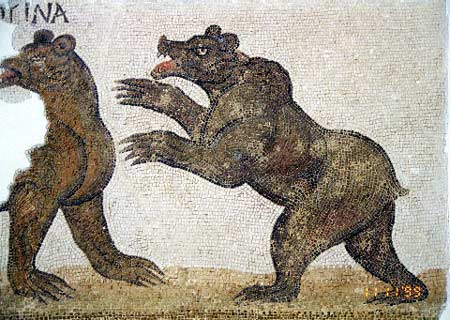Atlas Bear Claims
Posted by: Loren Coleman on July 24th, 2008

The extinct Atlas bear (Ursus crowtheri), above, continues to live on in dispute, even here on the pages of Cryptomundo. Today, round two in the battle between a German commentator and a French respondent.
Michel Raynal is one of the foremost cryptozoologists in Europe, the webmaster of Virtual Institute of Cryptozoology, the first French site devoted to cryptozoological research.

Raynal, pictured above, passes along some comments, below, in response to German comment maker Sordes’s claims on the Atlas bear published at Cryptomundo, which can be found more completely here:
Sordes’s comments:
“Around 1900 (or a bit later) bones of this animals were discovered in a cave associated with late roman artefacts”

Raynal replies:
Not around 1900: it was a discovery by Bourguignat (1867, 1870), but as no stratigraphic survey was made, the case was considered controversial.
Sordes’s comments:
“The Jardin de Plantes in Paris even housed a specimen which was a present from the emperor of Morocco.”
Raynal replies:
No, the specimen was sent to the Marseilles (not Paris) museum as mentioned by Loche (1867), but we have no remains of this animal (neither a skull nor a pelt), and no mention in the museum of Marseilles archives (which were burnt at one time).

Sordes’s comments:
“I have never heard before that the existence of the Atlas bear was ever in doubt. I made a lot of research about this animal for a chapter in my book about holocene megafauna-extinctions, and there was never any hint that there was criticisms about its existence”
Raynal replies:
I wonder what kind of research he made, as the existence of this bear was greatly disputed by such authorities as mammologist Angel Cabrera (1932) and even much more recently by Kazimierz Kowalski and Barbara Kowalska-Rzebik (1991), as stated on my own web pages, which provides the most documented analysis on the Atlas bear, including the data for the anecdotes above.
The referenced pages are in French, and can be found at Michel Raynal’s site, entitled “L’ours de l’Atlas a vraiment existé par Michel Raynal (dernière mise à jour : 08 octobre 2005)” and “L’ours de l’Atlas (dernière mise à jour : 09 août 1999).” Found at his Virtual Institute of Cryptozoology, and you will discover these French essays within his “Une discipline qui enregistre des succès (dernière mise à jour : 06 juillet 2003),” specifically here.

About Loren Coleman
Loren Coleman is one of the world’s leading cryptozoologists, some say “the” leading living cryptozoologist. Certainly, he is acknowledged as the current living American researcher and writer who has most popularized cryptozoology in the late 20th and early 21st centuries.
Starting his fieldwork and investigations in 1960, after traveling and trekking extensively in pursuit of cryptozoological mysteries, Coleman began writing to share his experiences in 1969. An honorary member of Ivan T. Sanderson’s Society for the Investigation of the Unexplained in the 1970s, Coleman has been bestowed with similar honorary memberships of the North Idaho College Cryptozoology Club in 1983, and in subsequent years, that of the British Columbia Scientific Cryptozoology Club, CryptoSafari International, and other international organizations. He was also a Life Member and Benefactor of the International Society of Cryptozoology (now-defunct).
Loren Coleman’s daily blog, as a member of the Cryptomundo Team, served as an ongoing avenue of communication for the ever-growing body of cryptozoo news from 2005 through 2013. He returned as an infrequent contributor beginning Halloween week of 2015.
Coleman is the founder in 2003, and current director of the International Cryptozoology Museum in Portland, Maine.










Bears were as common in the Roman games as lions and leopards. Populations of each in North Africa, Asia and Europe were decimated to meet demand for such contests in all the Roman provinces. Was there ursine population in the Atlas Mountains ? Why not ? North Africa was not an arid desert in Roman times and the Atlas Mountains were forested, cooler and wet. Great habitat for bears.
The historic range of the brown bear (of which the Atlas bear is/was almost certainly a subspecies) and the proximity of that range to the High Atlas makes the existence of this bear a virtual certainty.
The atlas bear is one of the recently extinct animals about which you can actually found not very much, so there were no very vast researches possible. The biggest part of my information came from The Doomsday Book of Animals by David Day. It mentions several historic reports about north african bears.
There are several antique reports about north african bears, for example by Herodotus, Virgil, Juvenal and Martial. They spoke about Lybian bears, but actually that is not really far away from the Altas mountains. The southern part of the mediteranean sea was once at most regions very similar to those parts still seen in southern Europe, i.e. a lot of forests and with much more moisture than today. The fauna of this regions was also very similar, even the Aurochs was once found in northern Africa.
The roman magistrate Domitius Ahenobarbus wrote in 61 BC that 100 Numidian bears were brought to Italy to be slaughtered in the arena. There are also notions of Trabus that north-african warriors wore not only the pelts of lions but also of bears.
I didn’t checked my own written texts when I wrote about the bear in the Zoo, but just from my memory, but at my original I wrote about the right place in Marseille, not the Jardin de Plantes.
Same thing with the discovery of the bones, I didn’t remember the correct date, but in my manuscripts I had the correct date. It is not really a wonder that no remains were conserved, because it was not always normal to conservate the bones and hides of animals from the zoos, especially in the cases of comparable normal animals like bears.
There were also several contemporary mentions about the atlas bear by Shaw (1800) and Crowther (1840).
I found also mentions of the atlas bear in “Extinct and vanishing mammals of the Old World” by Francis Harper, in “Extinct and Vanishing Animals” by V. Ziswiler and in “Grizmeks Tierleben Säugetiere Band 3” by Bernhard Grizmek. With the exception of a small mention in “Extinct and vanishing mammals of the old world” that Cabrera doubted the existence of the altas bear, there was nowhere any hint that there was ever a general rejection against the very existence of the atlas bear. Like in so many other cases it seems that only a handful of individual scientists had their personal doubts, what is very common, but no general doubts like in the Case of Gesners Forest-Raven which much later turned out to be the northern bald ibis.
An additional note to the extinct lemurs of Madagascar: Even if there was no C14-testing method several decades ago, it was already very sure that those animals became extinct just a very short time ago, as many of their remains were in a subfossil and and very fresh state, and doubtless not older than several hundred of perhaps one thousand years old. Already in 1893 C. I. Forsyth Major wrote at “On Megaladapis madagascariensis, an Extinct Gigantic Lemuroid from Madagascar” that it is possible that some of the folkloristic creatures of the malagasy people has its base in Megaladapis, so this was not even a discovery by Heuvelmans.
Sadly my french is not very good, so I was hardly able to consult the data from Monsieur Raynal’s site, otherwise H had have further information.